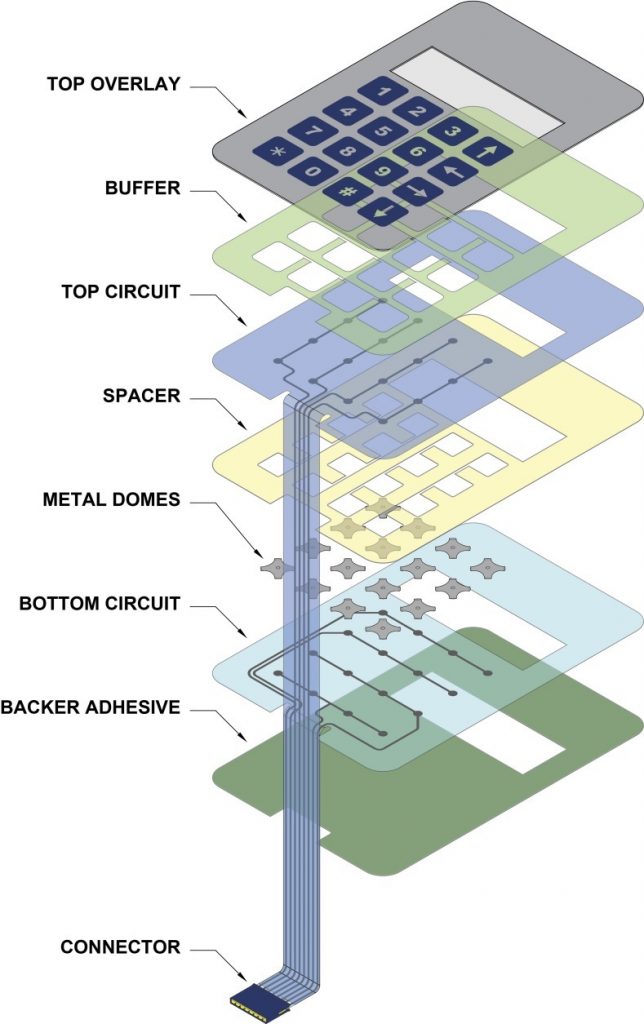Comprehending Membrane Switches Over: The Trick to Dependable and durable Controls
Membrane switches over stand for a crucial facet of modern interface design, blending performance with resilience in different applications. These versatile elements not only assist in customer communication but are likewise crafted to stand up to the roughness of demanding environments, from medical gadgets to commercial machinery. Recognizing their building and construction, operation, and the myriad advantages they offer is necessary for designers and designers alike. As we discover the details of membrane buttons, it ends up being clear that their function in enhancing control systems is both complex and extensive, questioning regarding how finest to leverage their abilities in future technologies.
What Are Membrane Buttons?
Membrane layer switches are an innovative solution in the world of user interface innovation, incorporating functionality and design effortlessly. These tools serve as a user interface in between customers and digital systems, integrating several components into a portable layout. Generally built from versatile, thin layers of products, membrane layer buttons are made to react to touch, enabling customers to interact with machinery and electronic devices efficiently.
The main elements of a membrane switch include a printed circuit layer, graphic overlay, and a spacer layer that prevents unintended activation. The visuals overlay can be tailored to mirror brand name identification or customer preferences, boosting visual appeals while guaranteeing usability. Membrane buttons are frequently used in different applications, including medical devices, customer electronic devices, and industrial equipment, owing to their durability and resistance to ecological elements such as wetness and dust.
One of the essential advantages of membrane layer buttons is their capability to stand up to wear and tear, making them perfect for high-traffic environments. Additionally, they are lightweight and call for very little space, permitting for ingenious designs in item advancement. Overall, membrane switches over stand for a efficient and functional option for modern digital interfaces, weding technology with user-centric layout principles.

How Membrane Switches Job
The procedure of membrane switches over joints on a basic yet effective device that equates customer input into digital signals. When a user presses the switch, the top layer deforms, permitting a conductive aspect in the circuit layer to make call with a matching conductive pad on the bottom of the graphic overlay.
The layout of membrane buttons can vary, yet they typically include domes or responsive elements to supply feedback to the individual, boosting the general experience. The materials made use of in membrane buttons, such as polyester or polycarbonate, add to their toughness and resistance to environmental aspects, consisting of dampness and dust. The published circuits are usually enveloped, which secures them from wear and tear over time.

Advantages of Membrane Layer Switches
One of the main benefits of membrane layer buttons is their convenience in layout, allowing them to be personalized to fulfill particular user demands and visual demands. This versatility reaches various industries, where different forms, dimensions, and shades can be used to enhance user interaction and visual appeal.
Additionally, membrane layer switches are understood for their durability. Built from robust materials, they are resistant to dirt, dampness, and physical wear, which dramatically extends their life expectancy compared to standard mechanical buttons. This resilience makes them especially suitable for high-traffic environments and applications calling for longevity.

Additionally, membrane switches provide a structured account, resulting in a thinner style that can be integrated into various devices without including bulk. This feature not just boosts the visual charm however additionally adds to a more ergonomic item layout.

Applications of Membrane Layer Buttons
Versatile and straightforward, membrane switches find applications across a variety of sectors, including clinical devices, consumer electronic devices, and industrial tools. In the medical area, these buttons are essential to devices such as analysis devices, patient surveillance systems, and infusion pumps, where integrity and ease of cleansing are vital. Their capacity to maintain and hold up against harsh settings functionality makes them ideal for such applications.
In customer electronic devices, membrane switches are utilized in products like microwaves, washing equipments, and push-button controls - membrane switch. Their streamlined layout enables for intuitive customer interfaces, boosting the general user experience while offering durability and resistance to tear and use
Commercial devices also takes advantage of membrane switches, especially in control panels for machinery and automation systems. These switches provide defense against dirt and wetness, guaranteeing regular efficiency in difficult settings. Moreover, their adjustable features enable suppliers to tailor them to specific operational demands, improving performance and functionality.
Selecting the Right Membrane Change
When selecting a membrane switch, it is essential to consider numerous elements that influence efficiency and viability for specific applications. The key factors to consider consist of ecological conditions, responsive feedback, sturdiness, and layout specifications.
First, assess the operating atmosphere; switches revealed to dampness, chemicals, or severe temperature levels require particular products to make certain long life and capability. Next off, review the click here for info need for tactile feedback. Relying click here to read on user communication, some applications might gain from a responsive reaction to validate activation, while others might prefer a non-tactile layout for aesthetic reasons.
Resilience is one more crucial variable; membrane buttons ought to be created to endure regular usage, impacts, and abrasion. Make sure the picked button can sustain the anticipated lifecycle, particularly in high-usage scenarios.
Conclusion
Finally, membrane layer switches over serve as crucial parts in the layout of trusted and durable control systems across different markets. Their small style, incorporated with robust construction and adjustable features, improves user communication while making sure durability popular environments. The convenience of membrane layer switches permits tailored solutions that satisfy certain operational requirements, strengthening their significance in modern technology. membrane switch. As industries continue to evolve, the relevance of incorporating effective membrane layer button options can not be overemphasized.
Membrane layer changes stand for an essential facet of modern user interface design, mixing performance with resilience in different applications.Membrane buttons are an innovative solution in the world of individual interface innovation, incorporating performance and design flawlessly. Normally created from flexible, slim layers of products, membrane switches are made to respond to touch, making it possible for customers to engage with equipment and electronic devices properly.
The style of membrane buttons can differ, but they frequently integrate domes or tactile elements to supply feedback to the individual, enhancing the total experience.In final thought, membrane switches over serve as necessary parts in the style of resilient and reliable control systems across various markets.